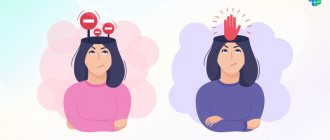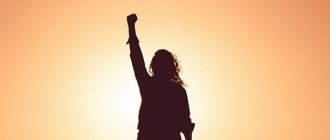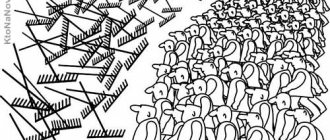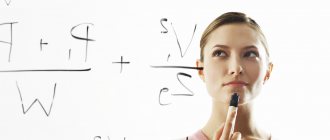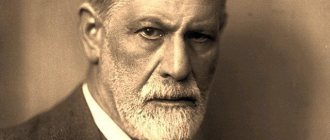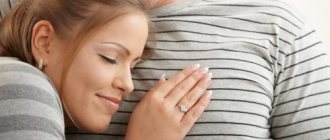Introduction
The healing effects of physical exercise on the human body have been known since ancient times. Their great importance for fighting diseases and prolonging life was pointed out by many generations of Greek doctors and philosophers in their works and statements. Thus, Aristotle said: “Life requires movement”... “Nothing depletes and destroys a person more than prolonged physical inactivity.”
Physical exercise is a very powerful means of changing a person’s physical and mental state. Properly organized classes strengthen health, improve physical development, increase physical fitness, and improve the functional systems of the human body. At the same time, it is necessary to understand that the uncontrolled and unsystematic use of physical education means is ineffective, and in some cases can cause irreparable harm to health, and everyone can give many examples of this. Monitoring and self-control measures for those involved themselves are designed to eliminate all conditions under which negative effects of physical exercise and sports may occur.
The purpose of control is to optimize the process of physical exercise based on an objective assessment of the state of the body.
Thanks to self-observation, the athlete has the opportunity to independently control the training process. In addition, self-control has great educational and pedagogical significance, accustoming the athlete to active observation and assessment of his condition, to analyzing the training methodology used.
Without physical activity, self-control decreases
Megan Oaten, a psychologist, and Ken Cheng, a biologist (from Kelly McGonigal's book Willpower: How to Develop and Strengthen it) from Macquarie University in Sydney recently finished testing a new treatment that increases self-control. The “guinea pigs” were six men and 18 women aged from
18 to 50 years old. After two months of treatment, they were able to concentrate better and
were less distracted. But that was not all. The subjects smoked less and reduced their consumption of alcohol and caffeine - although no one asked them to do this. They ate less junk food and more healthy food. We spent less time watching TV and more time studying. We saved money and spent less on spontaneous purchases. Feeling in control of your emotions. What is this miracle medicine and who will write the prescription?
Physical exercise worked wonders for self-control. Participants who had not previously exercised regularly were given a gym membership and encouraged to use it. In the first month they worked out about once every seven days, but by the end of the second month they were going to the gym three times a week. The researchers didn't ask them to make any other changes, and yet, thanks to sports training, people seemed to discover a new source of strength in themselves and became better at self-control in all areas of their lives.
Exercise, like meditation, enlarges and speeds up the brain, especially the prefrontal cortex.
How to understand that there are problems
In psychology, it is believed that the main reason for problems with self-control is such a quality as impulsiveness. It has many definitions, but the main essence is this: a person’s quick and unplanned reaction to external and internal stimuli. As a personality quality, impulsivity can be divided into four components:
- Haste is the tendency to act too quickly and recklessly, especially under stress or temptation.
- Insufficient thinking about your actions - deciding to take some action, losing sight of the possible consequences.
- Lack of perseverance - a person is not able to work for a long time on solving one problem, he is often distracted.
- Constant search for thrills.
This characteristic is conditional - all components are interconnected with each other, because they are consequences of the same problem.
An active lifestyle, good nutrition, and physical exercise create conditions for the development of self-control.
Concept of self-control
Self-control - during physical education and sports - regular monitoring of the person involved in physical education and sports over the state of his health, physical development, as well as the effect of physical activity on the body. Self-monitoring data significantly complements the information obtained during a medical examination. In addition, self-control also has an educational value, teaching a conscious attitude towards classes, observing the rules of personal hygiene, proper daily routine, and hardening.
In the process of self-control, they rely on subjective indicators - well-being, mood, sleep, appetite, performance, etc., as well as the simplest objective ones - heart rate and rhythm and breathing, body weight, muscle strength, etc. Basic functional tests can also be used for self-control , For example
orthostatic and orthoclinostatic, breath-hold test.
The number of indicators for self-control is determined by the health status of the student, his level of physical fitness and the assigned tasks. For example, for elderly people it is mandatory to control blood pressure, which is measured at least once a week.
After physical exercise, you should feel cheerful, your mood, appetite, and performance should be good. The practitioner should not experience a feeling of weakness or severe fatigue. In the absence of good health (lethargy, drowsiness, irritability), the presence of muscle pain, reluctance to exercise, you should temporarily (for 1-2 days) stop exercising and resume them, gradually increasing the load, if you feel worse (throbbing headache, heaviness in the back of the head, flickering spots before the eyes, tinnitus, nausea, etc.) you should stop exercising and consult a doctor.
The purpose of self-control is regular observation in simple and accessible ways of physical development, the state of your body, the influence of physical exercise or a specific sport on it.
Self-control tasks:
- Expand knowledge about physical development.
- Acquire skills in assessing psychophysical fitness.
- Familiarize yourself with the simplest available self-control techniques.
- Determine the level of physical development, fitness and health in order to adjust the load when engaging in physical education and sports.
Self-monitoring allows you to promptly identify the adverse effects of physical exercise on the body.
Basic self-control techniques:
- Instrumental
- Visual
For self-control to be effective, it is necessary to have an idea of the body’s energy expenditure. In case of neuropsychic and muscular stress that arises when performing educational activities in combination with systematic load, it is important to know the time intervals for rest and restoration of mental and physical performance, as well as techniques, means and methods by which the functional capabilities of the body can be more effectively restored.
physical Culture and sport
The terms "physical education" and "sport" have different meanings, although we often use the phrase "physical education and sport" and put the two words side by side.
Physical culture is an organic part of the general culture of society and the individual, a kind of social activity aimed at improving health, developing physical abilities and preparing them for life practice. Society recognizes such activities as useful and necessary for everyone and creates conditions for its development.
Indicators of the state of physical culture in society and the state are:
- A set of material and spiritual values created for the physical improvement of members of society;
- Level of health and physical development of people;
- The degree to which physical exercise is used in education, training, production and daily life, as well as for other purposes of social practice.
The concept of “physical culture” is the most general and broad. It also includes such a private, narrower concept as “sport”.
Sport is a component of physical culture, a type of social activity of people, which consists of an organized comparison of their strengths and physical capabilities in the struggle for championship or highest sporting achievements.
The term “physical culture” appeared at the end of the 19th century in England during the period of the rapid emergence of modern sports, but did not find widespread use in the West and over time almost disappeared from everyday life. However, in Russia, after the revolution of 1917, the term “physical culture” prevailed in all the highest Soviet authorities and became part of the scientific and practical vocabulary.
In 1918, the Institute of Physical Culture was opened in Moscow, in 1919 the All-Obukhov Congress on Physical Culture was held, since 1922 the magazine “Physical Culture” has been published, since 1925 the magazine “Theory and Practice of Physical Culture” has been published, which is still published today.
The very name “physical culture” means something very important. Physical culture is part of the general culture of mankind and has absorbed not only centuries of valuable experience in preparing a person for life, mastering, developing and managing natural physical and mental abilities, but, no less important, the experience of confirming and consolidating the moral and ethical principles of a person, which manifest themselves in the process of physical culture activities.
Thus, physical culture, contrary to its literal meaning, reflects the achievements of people in improving their physical, as well as, to a large extent, mental and moral qualities. The level of development of these qualities, as well as personal knowledge, skills and abilities to improve them, form the personal values of physical culture and determine the physical culture of an individual as one of the facets of general human culture. Social and biological foundations of physical culture.
There is no greater value for an individual and society as a whole than health.
Physical activity plays a significant role in the activities of members of society, therefore knowledge and skills in the field of physical education should be gradually introduced into educational institutions at various levels.
Higher education institutions also play an important role in physical education and training, where teaching must be based on clear methods, which together form a well-organized and well-established methodology for teaching and training students.
Assessing self-control indicators and conducting functional tests.
The heart rate response to physical activity can be assessed by comparing heart rate (HR) data at rest and after exercise, i.e. determine the percentage of heart rate increase. Heart rate at rest is taken as 100%, the difference in frequency before and after exercise is taken as x. For example, heart rate at rest (before the load) for 10 s is 12 beats, and after the load for 10 s in the first minute of recovery - 20 beats. A proportion is drawn up
12—100
(20—12)—x
and the percentage of heart rate increase is calculated:
.
Consequently, heart rate after exercise increased by approximately 66.6%. A sharp (80–90%) increase in heart rate in the first minute after exercise indicates a load exceeding the functional capabilities of the exerciser. It must be borne in mind that the acceptable limit for increased heart rate for people in older age groups is 130 - 140 beats per 1 minute; with a correctly selected load, heart rate is restored after 5-10 minutes. Slow recovery of heart rate indicates excessive load or an unsuccessful set of exercises.
Observations of heart rate are recommended to be combined with orthostatic and orthoclinostatic tests, which characterize the state of the cardiovascular autonomic nervous system. An orthostatic test is carried out as follows. The student lies on the couch for 5 minutes, after which he counts the heart rate for 15 seconds, then gets up and counts the heart rate again. Normally, when moving from a lying position to a soy position, there is an increase in heart rate by 10-12 beats per minute. An increase in heart rate up to 18 beats per minute is satisfactory. This increase in heart rate indicates insufficient nervous regulation of the cardiovascular system. Orgoclinostatic test - determination of the emergency situation during the transition from a standing position to a lying position. Normally, there is a decrease in heart rate by 4-6 beats per minute. A more pronounced slowdown of the pulse indicates increased tone of the autonomic nervous system. The higher the athlete’s fitness, the smaller the difference in heart rate during the orthoclinostatic test. Both of these tests are recommended to be carried out in the morning, immediately after waking up.
An indirect energy characteristic of the heart’s activity can be the so-called coefficient of economization of blood circulation, defined as the product of pulse blood pressure (the difference between systolic and diastolic blood pressure) and heart rate. Normally, this indicator fluctuates within a fairly wide range (from 2000 to 6000), averaging about 2800.
To carry out a breath-hold test (Stange test), you need to inhale, then exhale deeply and inhale again, then hold your breath, pinching your nose with your thumb and forefinger and recording the time you hold your breath with a stopwatch. It should be at least 20-30 s (well-trained athletes hold their breath for 60-120 s). As you train, the time you hold your breath increases, but if the student is overtired or overtrained, the ability to hold your breath sharply decreases. A similar test is carried out with holding the breath while exhaling (Gench test). In this case, holding your breath should be 20-30 s (for well-trained athletes - 60-90 s).
The reaction of the neuromuscular system is important when engaging in physical exercise. In practice, hand strength is measured with a hand dynamometer and then the strength index is calculated (the dynamometer readings are divided by the exerciser’s body weight and multiplied by 100). On average, this index (relative hand strength) for men is 70-75, for women – 50-60. With systematic physical exercise, hand strength gradually increases.
The functional state of the neuromuscular system can be examined using a tapping test. To do this, determine the maximum frequency of hand movement for a fixed period of time. Sitting at a table, the student exercises on command (with a stopwatch turned on at the same time) at maximum speed for 1 minute, moving (on command) from square to square every 10 seconds. After repeating the “stop” command 6 times, work is stopped and the number of points in each square is counted. The maximum frequency of hand movements in the first 10 s characterizes the mobility of nervous processes. In trained people, the number of points in the first square is at least 70; a gradual (more than 15-20 points) decrease in each subsequent square indicates insufficient functional stability of the neuromuscular system.
In addition, static stability studies can be carried out. Body stability tests (Romberg pose) involve the student taking the basic stance: feet together, arms extended forward, fingers spread, eyes closed. The maximum stability time (at least 30 s) and the presence of hand tremor are determined. In trained people, the stability time increases as the functional state of the neuromuscular system improves (up to 1 minute or more).
It is necessary to systematically check the flexibility of the spine. The practitioner, standing on a raised platform (on a bench, chair), leans forward (legs straight!). the result is recorded: with a + sign if the fingers fall below the level of the feet, and with a - sign if the fingers do not reach the base of the bench or chair. Negative results indicate insufficient flexibility of the spine.
The accepted indicators should always be determined under approximately the same conditions (preferably in the morning, after getting up), and also periodically before and after classes. Participants record their observations in a self-monitoring diary, which reflects any violation of the regime (for example, alcohol consumption), complaints, or past illnesses. The self-monitoring diary should be periodically reviewed by a doctor at a medical and physical education clinic (for athletes, a sports doctor and coach). When analyzing self-control indicators, one should take into account the age and gender of the student, and his level of physical fitness.
